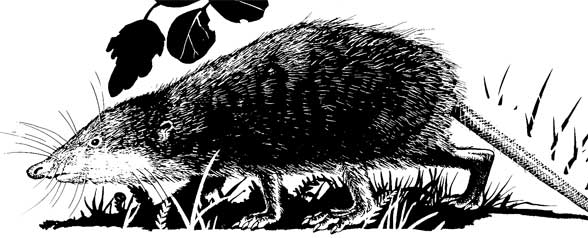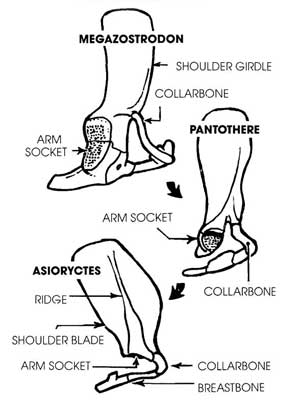
Asioryctes nemegetensis. Early Campanian of Mongolia (Late Cretaceous, Djadokhta Formation). Artwork by David Peters - Asioryctes
| Eutheria | ||
| The Vertebrates | Asioryctitheria and Cimolestidae |
| Vertebrates Home | Vertebrate | Vertebrate |
|
Abbreviated Dendrogram
Mammalia
├─Metatheria
└─Eutheria
└─┬─Eomaia
└─┬─Adapisoriculidae
└─┬─Zhelestidae
└─┬─┬─Asioryctitheria
│ └─Cimolestidae
│ ├─┬─Maelestes
│ │ └─Batodon
│ └─Cimolestes
└─┬─Zalambdalestidae
└─┬─Leptictida
└─Placentalia
|
Contents
Overview |
Taxa on This Page
 Asioryctes nemegetensis. Early Campanian of Mongolia (Late Cretaceous, Djadokhta Formation). Artwork by David Peters - Asioryctes |
 Asioryctitheria : Asioryctes, Kennalestes, Ukhaatherium
Asioryctitheria : Asioryctes, Kennalestes, Ukhaatherium
Range: Late Cretaceous of Asia
Phylogeny: Eutheria ::: Adapisoriculidae + (Zhelestidae + (Cimolestidae + *) + (Zalambdalestidae + (Leptictida + Placentalia))).
Characters: lack a Meckelian groove. Furthermore they were equipped with double-rooted canines, a lower premolar with a reduced or absent metaconid and a more elongated lower premolar than their predecessors. In addition, the entoconid and hypoconulid on the lower molars are untwinned, the entotympanic is non-existent, the alisphenoid is enlarged, a Vidian foramen is present as well as a promontorium linked to the paroccipital process via the crista interfenestralis. - Wikipedia, in unusually technical mode - MAK111208
 Asioryctes had a fully modern shoulder blade in which the clavicle (collar bone) inserted into the base with no trace of coracoid in lateral view. The glenoid (shoulder socket) is not visible in lateral view. Insteand it opens ventrally. The ridge that developed along the anterior rim in pantotheres shifts to the middle in eutherians, like Asioryctes. This produces a forelimb that is tucked in close to the body during normal locomotion. David Peters - Asioryctes |
Comment: An interesting point about the lower jaw is the absence of a feature on the inside face called Meckel's groove. This was present in many more ancient mammals and even basal eutherians (eg. Eomaia and Prokennalestes. It occurs on the jaws of all living reptiles but not extant mammals. - Trevor Dykes - Mesozoic Mammals. Ukhaatherium is also known to have epipubic bones, which are not found in placentals (Novacek et al, 1997). This shows that Asioryctitheria were prior to apomorphic (not simply crown group) placentals. MAK120315
Note: At this time, the relationships and characters of the Asioryctitheria and Leptictida are sufficiently unclear that we defer any attempt to characterize them. ATW
Image: Asioryctes from THE FOSSIL RECORD-
Links: Re- (extinction) (long); Re- Condylarths (TINGAMARRA REVISITED); Asioryctes nemegtensis; MESOZOIC MAMMALS; 'basal' Epitheria, an internet directory; Transition from synapsid reptiles to mammals; Untitled Document. ATW021027.
Cimolestidae Batodon, Cimolestes, Maelestes
Range: Late Cretaceous to Late Paleocene, of Mongolia and North America
Phylogeny: Eutheria ::: Adapisoriculidae + (Zhelestidae + (Zalambdalestidae + (Leptictida + Placentalia)) + (Asioryctitheria + * : (Batodon + Maelestes) + Cimolestes.
Comments: The Cimolestids are a poorly known group of early mammals, characterised by one of the most primituve (plesiomorphic) dentitions among placentals. Few if any features link them specifically with any later taxa.Little is known about them beyond their teeth (as with Mesozic mammals, these are the hardest parts of the body and hence most likely to be preserved, especially with very small animals), but it seems they were approximately the size of living hedgehogs (Rose 2006 p.95). Recent cladistic analysis of Maelestes gobiensis Wible et al., 2007, a shrew-like mammal from the Djadokhta Formation of Mongolia (now, the the Gobi Desert, then, a home for dinosaurs, crocodiles, birds, and early mammals) shows that it was closely related to Cimolestes and its the contemporary Batodon (Wible et al. 2007, Wible et al. 2009). On these grounds it is assigned to the family Cimolestidae. Its relation to other genera assigned to this family, such as Telacodon and Procerberus, also from the North American Late Cretaceous Kielan-Jaworowska et al. (2004) and almost a dozen early Tertiary genera from North America, Europe, Africa, and Asia McKenna and Bell (1997), are not so clear. Previously associated with a diverse and probably polyphyletic assortment of archaic early Tertiary mammals, cladistic analysis reveals the Cimolestidae to be a non-placental Eutherian stem group (Wible et al. 2009, Giallombardo 2009). MAK111210
Links: Paleocene Mammals, Wikipedia MAK111210
Maelestes : M. gobiensis Wible et al., 2007
Range: Djadokhta Formation of Mongolia
Phylogeny: Cimolestidae : (Batodon + *) + Cimolestes.
Comments: The dentition of Maelestes shows a mosaic of features found in contemporary Late Cretaceous Asian taxa, with premolars like the Zhelestes, upper molars like the asioryctithere Kennalestes, and lower molars like Zalambdalestes. Maelestes is also the first Cretaceous eutherian found to have a marsupial-like palatal vacuity, a rare feature found in only a few extant insectivores. Postcrania are similar to those of the asioryctithere Ukhaatherium, and both are similar to, resemble, but more primitive than, placental insectivores Wible et al. 2009, MAK111210
Range: Late Cretaceous of North America
Phylogeny: Cimolestidae : (Maelestes + *) + Cimolestes
Comments: the smallest Cretaceous eutherian, with molars roughly 60% the size of Maelestes (Wible et al. 2009), MAK111210
Range: latest Cretaceous and early Paleocene of western North America
Phylogeny: Cimolestidae : Batodon + Maelestes) + *.
Comments: Prior to the discovery of Maelestes, this was generally considered the most primitive cimolestid genus, and until recently the only Mesozoic representative of the family (Rose 2006 p.95). Previously related to the Creodonts and Carnivora, new cladistic analysis places it as a stem eutherian (Wible et al. 2007) MAK111210
Links checked ATW051011. Page MAK111210